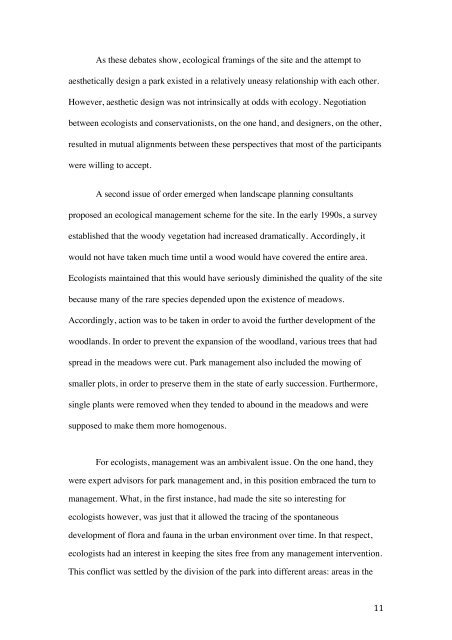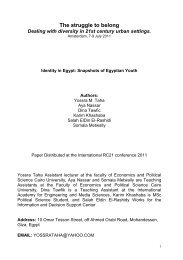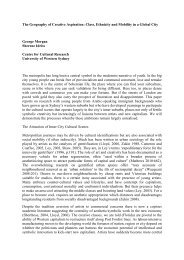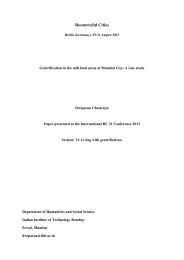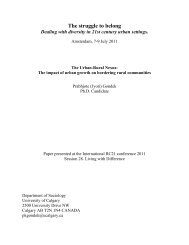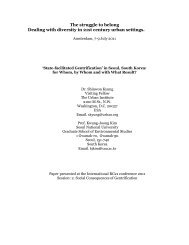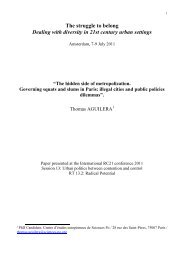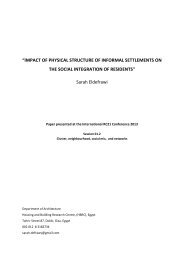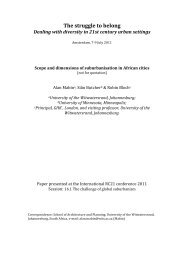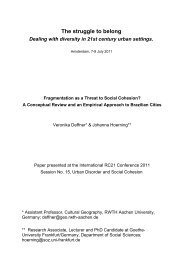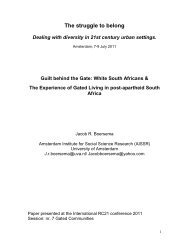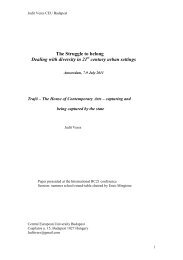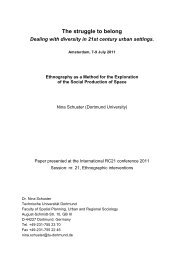The Invention of the Ruderal Area. Urban Ecology and the Struggle ...
The Invention of the Ruderal Area. Urban Ecology and the Struggle ...
The Invention of the Ruderal Area. Urban Ecology and the Struggle ...
Create successful ePaper yourself
Turn your PDF publications into a flip-book with our unique Google optimized e-Paper software.
As <strong>the</strong>se debates show, ecological framings <strong>of</strong> <strong>the</strong> site <strong>and</strong> <strong>the</strong> attempt to<br />
aes<strong>the</strong>tically design a park existed in a relatively uneasy relationship with each o<strong>the</strong>r.<br />
However, aes<strong>the</strong>tic design was not intrinsically at odds with ecology. Negotiation<br />
between ecologists <strong>and</strong> conservationists, on <strong>the</strong> one h<strong>and</strong>, <strong>and</strong> designers, on <strong>the</strong> o<strong>the</strong>r,<br />
resulted in mutual alignments between <strong>the</strong>se perspectives that most <strong>of</strong> <strong>the</strong> participants<br />
were willing to accept.<br />
A second issue <strong>of</strong> order emerged when l<strong>and</strong>scape planning consultants<br />
proposed an ecological management scheme for <strong>the</strong> site. In <strong>the</strong> early 1990s, a survey<br />
established that <strong>the</strong> woody vegetation had increased dramatically. Accordingly, it<br />
would not have taken much time until a wood would have covered <strong>the</strong> entire area.<br />
Ecologists maintained that this would have seriously diminished <strong>the</strong> quality <strong>of</strong> <strong>the</strong> site<br />
because many <strong>of</strong> <strong>the</strong> rare species depended upon <strong>the</strong> existence <strong>of</strong> meadows.<br />
Accordingly, action was to be taken in order to avoid <strong>the</strong> fur<strong>the</strong>r development <strong>of</strong> <strong>the</strong><br />
woodl<strong>and</strong>s. In order to prevent <strong>the</strong> expansion <strong>of</strong> <strong>the</strong> woodl<strong>and</strong>, various trees that had<br />
spread in <strong>the</strong> meadows were cut. Park management also included <strong>the</strong> mowing <strong>of</strong><br />
smaller plots, in order to preserve <strong>the</strong>m in <strong>the</strong> state <strong>of</strong> early succession. Fur<strong>the</strong>rmore,<br />
single plants were removed when <strong>the</strong>y tended to abound in <strong>the</strong> meadows <strong>and</strong> were<br />
supposed to make <strong>the</strong>m more homogenous.<br />
For ecologists, management was an ambivalent issue. On <strong>the</strong> one h<strong>and</strong>, <strong>the</strong>y<br />
were expert advisors for park management <strong>and</strong>, in this position embraced <strong>the</strong> turn to<br />
management. What, in <strong>the</strong> first instance, had made <strong>the</strong> site so interesting for<br />
ecologists however, was just that it allowed <strong>the</strong> tracing <strong>of</strong> <strong>the</strong> spontaneous<br />
development <strong>of</strong> flora <strong>and</strong> fauna in <strong>the</strong> urban environment over time. In that respect,<br />
ecologists had an interest in keeping <strong>the</strong> sites free from any management intervention.<br />
This conflict was settled by <strong>the</strong> division <strong>of</strong> <strong>the</strong> park into different areas: areas in <strong>the</strong><br />
<br />
11


